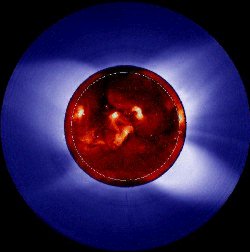Image of the solar corona in white light (outer circle, blue and white) and X-Rays (inner circle, red, yellow, and black) on April 22, 1994, courtesy of the High Altitude Observatory and the Yohkoh Science team. The dashed circle is the solar radius.
Click on image for full size
Image courtesy of the High Altitude Observatory, National Center for Atmospheric Research (NCAR), Boulder, Colorado, USA. NCAR is sponsored by the National Science Foundation.The solar X-ray image is from the Yohkoh mission of ISAS, Japan.
The Solar Atmosphere
The visible solar atmosphere consists of three regions: the
photosphere,
the chromosphere, and the solar corona. Most of the visible (white) light
comes from the photosphere,
this is the part of the Sun we actually see.
The chromosphere and
corona also emit white light, and can
be seen when the light from the photosphere is blocked out, as occurs in
a solar eclipse.
The sun emits electromagnetic radiation at many other wavelengths as well.
Different types of radiation (such as radio, ultraviolet, X-rays, and gamma
rays) originate from different parts of the sun. Scientists use
special instruments
to detect this radiation and study different parts of the solar atmosphere.
The solar atmosphere is so hot that the gas is primarily in a plasma state:
electrons are no longer bound to atomic nuclei, and the gas is made up
of charged particles (mostly protons and electrons). In this charged
state, the solar atmosphere is greatly influenced by the
strong solar magnetic fields that thread through it.
These magnetic fields, and the outer solar atmosphere (the corona) extend out into
interplanetary space as part of the solar wind.
You might also be interested in:

Above the photosphere is the chromosphere, a region about 2500 kilometers thick. Just prior to and just after the peak of a total solar eclipse , the chromosphere appears as a thin reddish ring. The conspicuous
...more
Even though they are far away, solar storms can affect us. They can disrupt our spacecraft and electrical power systems. So, figuring out how they happen and how we can predict them is important to NASA
...more
Scientists at the High Altitude Observatory (HAO) are working to understand the changes we see in the Sun over time, and how these changes affect the atmosphere of the Earth. There are four main areas
...more
What are the "parts" of the Sun? The photosphere, the visible "surface" of the Sun, defines the outermost boundary of the "inside" of the Sun. The three main regions of the
...more
Scientists use a broad array of techniques and instruments to make the measurements needed for space weather investigations. Telescopic observations via spacecraft and ground-based observatories provide
...more
Observations by Earth-orbiting satellites and other spacecraft have revolutionized our understanding of the Sun and space weather in recent years. A host of spacecraft provide a flood of information about
...more
On Earth, certain conditions in our atmosphere give rise to powerful storms - thunderstorms, blizzards, tornadoes, hurricanes, and the like. The Sun also has an atmosphere, and incredible storms that dwarf
...more
Surprisingly, humans have observed sunspots for a very long time, so historical sunspot observations provide us with some of our best long-duration records of solar activity. Large sunspots can sometimes
...more















